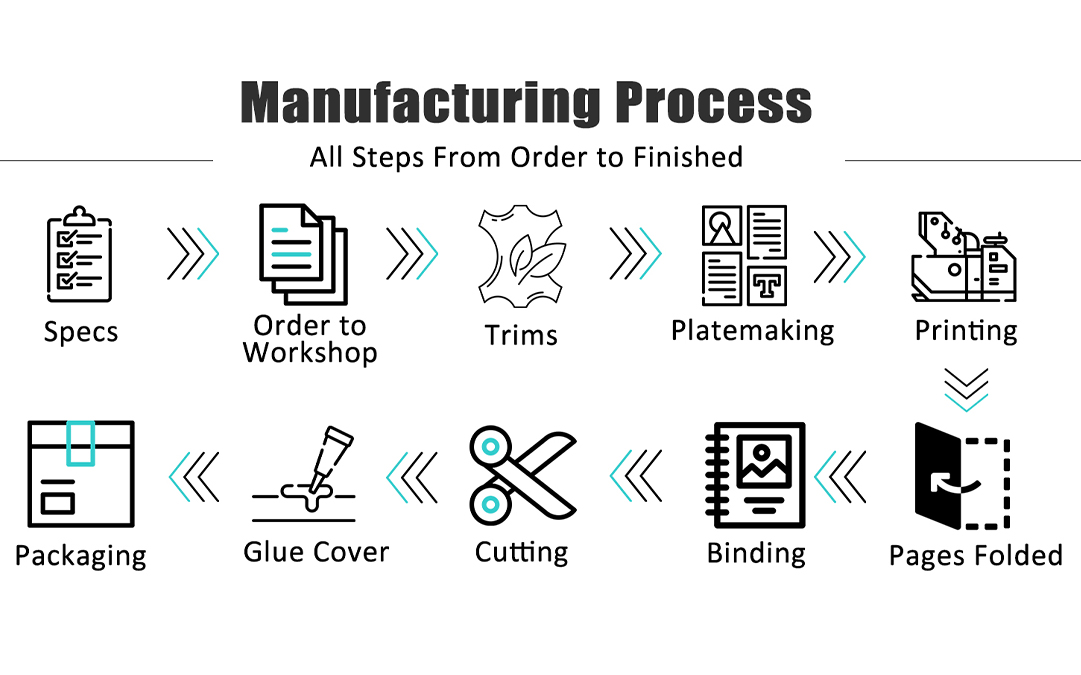The Key Metrics to Measure the Success of Your Custom Notebook Printing Campaign
As a business owner specializing in custom notebook printing, it’s crucial to measure the success of your marketing campaigns effectively. With every campaign, understanding what works and what doesn’t can make a significant difference in maximizing your return on investment (ROI). Here, I’ll share the key metrics I track to gauge the effectiveness of my custom notebook printing campaigns. By monitoring these metrics, you can gain valuable insights into your campaign’s performance and make data-driven decisions to optimize future efforts.
1. Sales Revenue
One of the primary metrics I track is the sales revenue generated from my custom notebook printing campaign. This metric directly reflects the financial success of the campaign. By comparing sales figures before, during, and after the campaign, I can gauge its impact on my overall business performance. It’s essential to break down revenue by different product types, such as custom covers, specialized bindings, and personalized packaging, to identify which offerings are most appealing to customers. Additionally, analyzing revenue trends over time helps in understanding seasonal demands and planning future campaigns accordingly.
2. Conversion Rate
Another crucial metric is the conversion rate, which measures the percentage of visitors to my website who make a purchase. This metric is essential for understanding how effective my campaign is at turning interest into actual sales. By tracking conversion rates, I can assess the effectiveness of my landing pages, calls to action, and overall user experience. It’s important to experiment with different designs and messages to see what resonates best with my audience. A higher conversion rate indicates that my marketing strategies and website optimizations are successfully encouraging visitors to buy custom notebooks.
3. Customer Acquisition Cost (CAC)
Customer Acquisition Cost (CAC) is a key metric that helps me understand the cost-effectiveness of my marketing efforts. It calculates the total cost spent on acquiring a new customer, including advertising expenses, promotional offers, and other related costs. By comparing CAC against the lifetime value of a customer, I can determine if my campaign is financially sustainable. Lowering CAC while maintaining or increasing customer quality is a sign of an efficient campaign. This metric also highlights areas where I can cut costs or optimize spending to improve profitability.
4. Return on Investment (ROI)
Return on Investment (ROI) is perhaps one of the most critical metrics to track. It measures the profitability of my custom notebook printing campaign by comparing the revenue generated to the total costs incurred. A positive ROI indicates that the campaign is generating more money than it costs, which is the ultimate goal. Calculating ROI helps me decide whether to continue, scale up, or pivot my marketing strategies. It also aids in justifying the budget allocation for future campaigns. Understanding the ROI allows me to focus on the most profitable aspects of my campaign.
5. Customer Retention Rate
The Customer Retention Rate is essential for evaluating the long-term success of my campaign. It measures the percentage of customers who make repeat purchases. High retention rates indicate customer satisfaction and loyalty, which are critical for sustained business growth. By tracking this metric, I can identify the effectiveness of my follow-up strategies, customer service, and product quality. Implementing loyalty programs, personalized follow-ups, and exceptional after-sales service can help improve retention rates, ensuring that customers keep coming back for more custom notebooks.
6. Website Traffic
Monitoring website traffic provides valuable insights into the effectiveness of my marketing efforts. By analyzing the number of visitors to my site, I can determine the reach and visibility of my campaign. It’s important to track both overall traffic and specific sources, such as organic search, paid ads, social media, and referrals. An increase in traffic suggests that my marketing strategies are successful in attracting potential customers. Additionally, understanding visitor behavior on my site, such as pages visited and time spent, helps in optimizing user experience and content relevance.
7. Social Media Engagement
Social media engagement is a crucial metric for understanding how well my campaign resonates with my audience. This includes likes, shares, comments, and overall interaction on platforms like Facebook, Instagram, and Twitter. High engagement rates indicate that my content is interesting and valuable to my followers. By monitoring this metric, I can identify which types of posts perform best and adjust my content strategy accordingly. Engaging with my audience through comments and direct messages also helps build a loyal community and enhances brand visibility.
8. Customer Feedback and Reviews
Collecting and analyzing customer feedback and reviews is vital for measuring the success of my custom notebook printing campaign. Positive reviews and high ratings reflect customer satisfaction and trust in my products. Feedback, whether positive or negative, provides insights into areas of improvement and customer preferences. By addressing concerns and implementing suggestions, I can enhance product quality and customer experience. Encouraging satisfied customers to leave reviews also helps in building credibility and attracting new customers through social proof.
9. Email Marketing Metrics
Email marketing metrics, such as open rates, click-through rates, and conversion rates, provide valuable information about the effectiveness of my email campaigns. High open rates indicate that my subject lines are compelling, while high click-through rates suggest that the content is engaging and relevant. Monitoring these metrics helps in refining my email marketing strategy, including segmentation, personalization, and timing. By continuously optimizing my email campaigns, I can drive more traffic to my website and increase sales of custom notebooks.
10. Market Share
Tracking my market share helps me understand my position relative to competitors. It measures the percentage of total sales in the custom notebook printing industry that my business captures. An increasing market share indicates that my campaign is successful in attracting customers from competitors and growing my brand presence. Analyzing market trends and competitor strategies provides insights into potential opportunities and threats. By staying informed about the competitive landscape, I can make informed decisions to strengthen my market position and drive business growth.
11. Customer Lifetime Value (CLV)
Customer Lifetime Value (CLV) is a crucial metric that helps me understand the total value a customer brings to my business over their entire relationship with my brand. This metric is essential for assessing the long-term profitability of my custom notebook printing campaign. By analyzing CLV, I can identify the most valuable customer segments and tailor my marketing efforts to attract and retain similar customers. Increasing CLV through upselling, cross-selling, and exceptional customer service can significantly enhance overall revenue and business growth.
12. Cart Abandonment Rate
The cart abandonment rate is an important metric that measures the percentage of visitors who add products to their shopping cart but do not complete the purchase. A high abandonment rate indicates potential issues in the checkout process, such as complicated navigation, unexpected costs, or lack of payment options. By tracking this metric, I can identify and address these obstacles to improve the user experience and reduce abandonment. Implementing strategies like retargeting ads, follow-up emails, and simplified checkout processes can help recover lost sales and boost conversion rates.
13. Cost Per Click (CPC)
Cost Per Click (CPC) is a metric that measures the cost incurred for each click on my online ads. This metric is essential for evaluating the efficiency of my paid advertising campaigns. By monitoring CPC, I can determine the cost-effectiveness of different advertising platforms and keywords. Lowering CPC while maintaining or increasing ad performance helps maximize my marketing budget. Additionally, analyzing CPC trends over time allows me to optimize my bidding strategies and improve the overall return on ad spend (ROAS).
14. Average Order Value (AOV)
Average Order Value (AOV) is a metric that calculates the average amount spent by customers per transaction. This metric is important for understanding customer purchasing behavior and identifying opportunities to increase revenue. By tracking AOV, I can implement strategies such as upselling, cross-selling, and bundling to encourage higher spending. Analyzing AOV trends also helps in tailoring marketing campaigns to promote higher-value products and drive overall sales growth. Increasing AOV directly contributes to improved profitability and business performance.
15. Click-Through Rate (CTR)
Click-Through Rate (CTR) is a metric that measures the percentage of people who click on my ads or links compared to the total number of views. This metric is crucial for assessing the effectiveness of my advertising and email marketing efforts. A high CTR indicates that my ad copy, visuals, and calls to action are compelling and relevant to my target audience. By tracking CTR, I can identify which campaigns and creatives perform best and optimize my marketing strategies accordingly. Improving CTR helps drive more traffic to my website and increases the likelihood of conversions.
Conclusion
Tracking these key metrics is essential for measuring the success of my custom notebook printing campaign. Each metric provides unique insights into different aspects of the campaign, from financial performance to customer engagement and satisfaction. By continuously monitoring and analyzing these metrics, I can make informed decisions to optimize my marketing strategies, improve customer experience, and ultimately drive business growth. Whether it’s increasing sales revenue, enhancing customer retention, or lowering acquisition costs, these metrics help ensure that my campaigns are effective and profitable.
In addition to these metrics, staying updated with industry trends and continuously learning from each campaign’s performance is vital. The custom notebook printing industry is competitive, and keeping a close eye on these metrics will help me stay ahead. By leveraging these insights, I can create more targeted and successful campaigns, attract more customers, and build a strong and loyal customer base.
For those in the custom notebook printing business, focusing on these metrics will not only help measure success but also provide a roadmap for continuous improvement and growth. As we adapt to changing market conditions and customer preferences, these metrics serve as a reliable guide to ensure that our marketing efforts are always aligned with our business goals.
By following these strategies and keeping a close eye on these metrics, you can ensure that your custom notebook printing campaigns are successful and contribute significantly to your business growth.
Contact Us: Ms. Rimo Lau WhatsApp Me
Whatsapp: 0086 18336352791 – WeChat&Phone
Website: www.fullcolorprintstationery.com
E-Mail: [email protected]





